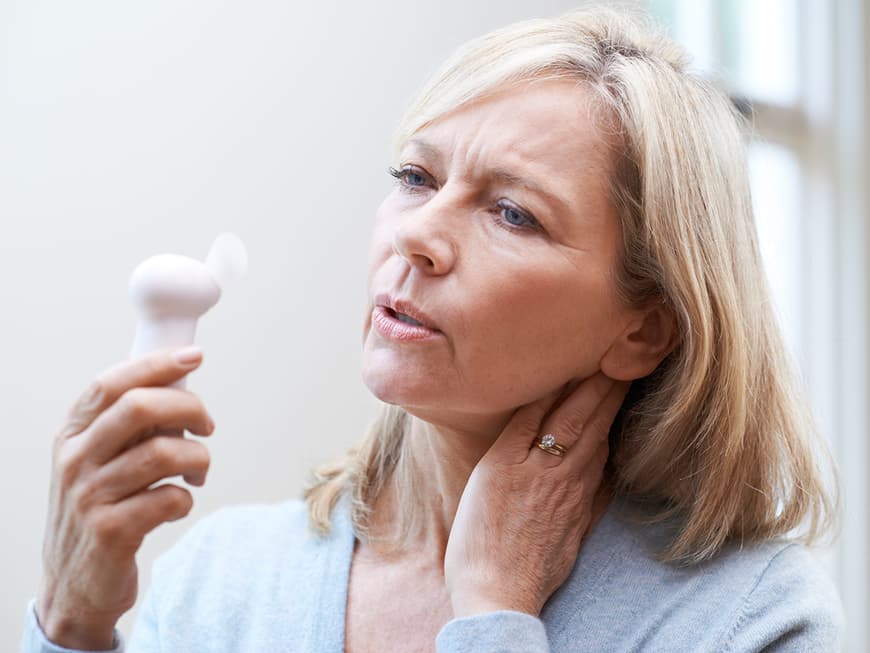
The occurrence of hot flushes during the menopause
Around 90 percent of all women experience hot flushes during the menopause. They occur most frequently at the beginning of the menopause and then decrease again. The hot flushes often disappear after one to two years. These episodes can occur up to 20 times a day, usually last a few minutes and vary in severity from woman to woman. The hot flushes are usually heralded by a feeling of pressure in the head and a slightly fluctuating feeling of discomfort before waves of warmth flood the body. Hot flushes during the menopause occur when blood vessels dilate and external areas of the body are supplied with more blood. This causes the skin to flush, the body temperature to rise and sweating to break out. If the body temperature then drops again, many people usually feel an unpleasant chill. This is sometimes accompanied by a slight palpitation, which usually calms down again immediately. This is just a natural reaction of the circulatory system. Incidentally, it is not uncommon for hot flushes to occur at night, which can deprive you of sleep.
Causes and possible illnesses
Hot flushes occur most frequentlyduring the menopause. According to experts, the cause is the increased release of stress hormones such as adrenaline, which is due to a drop in oestrogen levels. During the menopause, the production of the sex hormone oestrogen decreases and the brain's temperature regulation is dysregulated. In addition to the change in hormones, there are other factors that can promote hot flushes during the menopause:
- Stress and excessive exertion
- being overweight
- Excessively high temperatures in the bedroom
- incorrect clothing that is too warm
- spicy food
- food that is difficult to digest
- alcohol
- coffee, tea, caffeinated drinks
However, hot flushes do not necessarily have to occur during the menopause. Medication or illnesses can also cause hot flushes. Anti-oestrogenic medication, for example, can also cause the hormone to stop multiplying. Drugs used to treat hormone-sensitive cancer cause the body to go through the menopause, which means that younger women can also suffer from hot flushes.
The following diseases can be accompanied by hot flushes as a side effect:
- In tumors, especially carcinoids, the cancer develops in hormone-producing cells and is often accompanied by hot flashes.
- Diabetes with hypoglycemia often causes sweating.
- Hyperthyroidism causes heat sensitivity, hot flushes and rapid sweating.
- Allergic reactions can also cause heat sensitivity.
Treatment options and tips for hot flushes
To rule out a disease, a doctor should first confirm the menopause. To do this, he or she must ask about cycle fluctuations and symptoms and examine the reproductive organs and breasts. A blood test is also often carried out to check the concentration of female sex hormones such as oestrogen, progesterone, FSH and LH. This helps to find out whether you are already in the menopause or whether there are other causes for the hot flushes. There are numerous treatment options to treat the hot flushes. Medicinal plants are controversial, as their effect has not been fully proven. In tablet form, for example, black cohosh is said to have a soothing effect on hot flushes during the menopause. Sage, soy, red clover and yarrow are also used to combat this. In addition to herbal medicine, there are also physical therapy versions. Foot baths and partial soaks with alternating temperatures and mud baths can also prove helpful. Acupuncture and hot and cold showers are further treatment methods. If none of this helps, HRT hormone replacement therapy is another option. This involves taking hormones on a regular basis, but is associated with a risk of illness. The decision should be made carefully and discussed in detail with your doctor.
In addition to the medical treatment options, there are also simple measures that you can take yourself to alleviate the symptoms:
- A cool environment during sleep can prevent and reduce hot flushes during the menopause. It is also best to use cotton bed linen.
- Yoga, progressive muscle relaxation and autogenic training reduce stress, which can also cause hot flushes.
- People who are overweight sweat more. So keep an eye on your weight and try to lose excess pounds if necessary.
- Sufficient exercise is important. Even walking in the fresh air can help.
- Drink less caffeinated drinks such as coffee and tea, especially in the evening.
- Focus on easily digestible foods such as vegetables, fruit, salads and less spicy food.
- Textiles made of pure natural fibers such as cotton are preferable to those made of pure plastic, as these can increase sweating.
- Have the right clothing ready so that changing body temperatures can be taken into account. For example, you can wear two airy tops and take one off if necessary.
